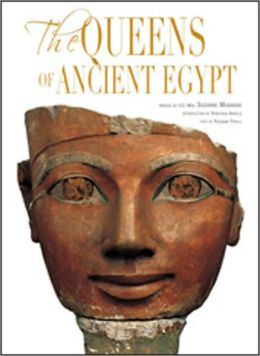
This beautiful book about the queens of ancient
The preface
is short, only one page. This is not surprising. I do not expect more than
this. The point is just to show that Suzanne Mubarak wants to lend her name to
this publication. The introduction is also short, only three pages. This is a
bit surprising. I would expect a more substantial contribution, maybe 10-15
pages, because this writer is an expert on ancient Egypt
The main
text is divided into four long chapters:
# 1: Women,
# 2: Women as Sovereigns
# 3: The Queens of Pharaonic Egypt
# 4: Cleopatra and the
Ptolemaic Queens
The book concludes with a chronology, an index and a list of photo credits.
This book is
published by White Star, an Italian publishing house which specialises in picture books in large format (also known as coffee table books). It is lavishly illustrated. In addition, it comes in a solid cardboard box
that will protect the book whether it is standing on a bookshelf or lying on a
desk.
All
illustrations are in colour, except for a few old photos which are in
black-and-white. In many cases, one motive gets a whole page. In some cases,
one motive gets two whole pages. As you work your way through this book, you
will see one great picture after another: pyramids, temples, tombs, statues,
portraits, furniture, jewellery and many other items connected to the queens of
ancient Egypt
Pirelli
seems to be very familiar with Egyptian history, but there is a mistake on page
244 where she says Ptolemy III was married to Berenice III. In fact, he was married
to Berenice II. The same mistake appears in the chronology (page 265). There
are two more mistakes on page 252:
Mistake # 1. She writes:
”… but Caesar’s death, far from re-establishing the balance of power between Pompey and Mark Antony, created further conflict…”
”… but Caesar’s death, far from re-establishing the balance of power between Pompey and Mark Antony, created further conflict…”
Why does she mention
Pompey here? Caesar was killed in 44 BC; Pompey (whose Latin name is Pompeius) was
killed in 48 BC. When Caesar was killed, Pompey had already been dead for four
years.
Mistake # 2. She writes:
“… at home a re-formulation of the agreement with Octavian and Lepidus was ratified byAntony
“… at home a re-formulation of the agreement with Octavian and Lepidus was ratified by
Mark Antony
(whose Latin name is Marcus Antonius) married Octavian’s sister, Octavia, in 40
BC. Octavian’s daughter (Julia) was not even born at that time. Julia was born in the following year, i.e. in 39 BC.
The British
Egyptologist Joyce Tyldesley has written a book about the same topic: Chronicle of the Queens of Egypt: From Early Dynastic Times to the Death of Cleopatra.
Pirelli’s
book was published by White Star in 2008, while Tyldesley’s book was published
by Thames & Hudson in 2006. It is natural to compare the two books with
each other.
The book
from White Star is almost twice as big as the book from Thames & Hudson (27
x 37 cm against 27 x 20 cm ), and it is longer (272 pages
against 224 pages). But I cannot say that one book is better than the other.
The strength of Pirelli’s book lies in the stunning illustrations. The strength
of Tyldesley’s book lies in the very informative text.
Inevitably,
many motives (illustrations) can be found in both books. For reasons of space, I
will mention only a few cases here:
** The huge cedar wood coffin of Meritamun
** The famous portrait of
Nefertiti that was found in 1912
** The temples built for Ramesses
II and Nefertari at Abu Simbel
** Wall decorations in Nefertari’s
tomb in the Valley of the Queens
** The model of a boat that was
found in the tomb of Ahhotep I
In one case – the devotional stele from Amarna showing Akhenaten, Nefertiti and their three daughters – the people from White Star have made a mistake. In the original, Akhenaten is sitting on the left with one daughter (Meritaten), while Nefertiti is sitting on the right with two daughters (Meketaten and Ankhesenpaaten) (see for instance Tyldesley, page 132). But in Pirelli’s book they have switched places: the huge picture in her book (pp. 199-200) is a mirror image!
Tyldesley
seems to be very familiar with Egyptian as well as Roman history. She does not
make the same mistakes as Pirelli: she knows Ptolemy III married Berenice II
(page 192); she knows Pompey was killed in 48 BC (page 201); and she knows Mark
Antony married Octavian’s sister (page 205). If only Pirelli had studied (the
last chapter of) this book, she could have avoided the embarrassing mistakes
which I mentioned earlier.
These
mistakes are unfortunate, and so is the mirror image. But in spite of these
flaws I want to say that this is an excellent book. If you are interested in ancient history - in particular the queens of ancient Egypt -
No comments:
Post a Comment